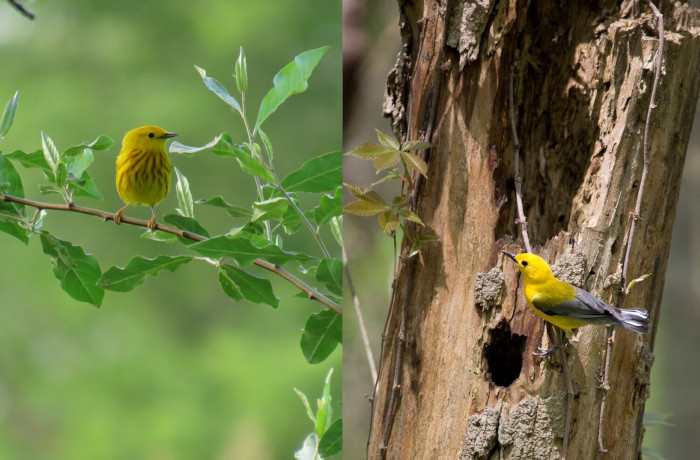Female cavity-nesting birds are more aggressive when defending nest sites
Not all birds behave alike - and it turns out female cavity-nesters may be among the most aggressive when space is limited.

(© Shelby Lawson and Michael Jeffords)
"Get off my lawn!" Funny as a meme but maybe scary in real life, this short sentence is synonymous with an elderly man shouting at kids whose bikes have gotten too close to a well-manicured front yard. But it could just as well represent a female bird, aggressively chasing whatever intruder gets too close to her nest.
Not any female bird, though. An international team of researchers led by Sara Lipshutz, assistant professor of Biology at Duke University, found that female birds who can only nest in cavities are far more aggressive than those who don't have this restriction on their nesting real estate.
Called obligate secondary cavity nesters, these are species that build their nests in pre-existing cavities in tree trunks, fence posts or rocky outcrops. "They can't excavate that cavity themselves, and they can't just build a nest anywhere," explained Lipshutz. "They have to find a hole in a tree, and this is the only way they can reproduce."
These specific needs—and the fact that they do not create these cavities themselves—mean that females with good nest sites have a precious resource to defend. And they do, with beaks and claws, and quite a bit of angry vocalizing.
Lipshutz's team focused on five families of birds: swallows, wood warblers, sparrows, thrushes and wrens, and on two closely related species per family—one an obligate secondary cavity nester, and one not. The researchers then strategically placed decoys corresponding to each species and Bluetooth speakers playing their call in the vicinity of nests and observed how the resident birds responded. Their work is published in Nature Ecology & Evolution.
As with so many other traits, one could expect aggressiveness to run in families, being more prevalent in some branches of birds' evolutionary tree than in others. What Lipshutz and her team found, however, was that aggressiveness is far more related to nest strategy than to family.
With the exception of never-aggressive sparrows and always-aggressive wrens, obligate cavity nesters were far more determined to get intruders off their lawn than their more versatile cousins. Among the obligate cavity-nesters, females were also more aggressive than males, possibly reflecting the higher cost they'd bear if their nest was lost.
"It was a really striking behavioural pattern," said Lipshutz.
The pressure to compete led to higher aggressiveness," added Kimberly Rosvall, a Duke alumna whose lab at Indiana University contributed to the project. "And this was especially strong for the females."
The team also looked at another frequent culprit of aggressiveness: testosterone. Once again, the results were surprising. Females from cavity-nesting species didn't have higher levels of testosterone.
If family and hormones can't explain why obligate cavity-nesters are particularly aggressive, could it be that aggressiveness is associated with specific genes? Lipshutz and her team looked at how genes are expressed—turned on or off—in each of their study species, to understand whether certain genes are repeatedly used in cavity-nesters. Their findings indicate both yes and no. Cavity-nesters expressed many of the same genes in the same manner, but fewer genes seemed to be consistently associated with aggression across all species.
"We always want to find the genes, a handful of genes that make a lot of sense, previously known genes that are associated with aggression and maybe have even been experimentally manipulated to impact aggression," said Lipshutz. "And we didn't find any of those usual suspects."
Lipshutz is far from disappointed, though. "There are probably several hundred genes associated with aggression and they're probably all working together in subtle ways. Those combinations are not the same for each species, which is really interesting from an evolutionary perspective," she said. "It shows that there are independent ways to get to the same behavioural outcome.
"As our team likes to say, 'There are many possible routes to build an aggressive bird.'"
Duke University
28 April 2025
More Information: "Repeated behavioural evolution is associated with convergence of gene expression in cavity-nesting songbirds" Nature Ecology & Evolution (2025). DOI: 10.1038/s41559-025-02675-x.
Share this story







